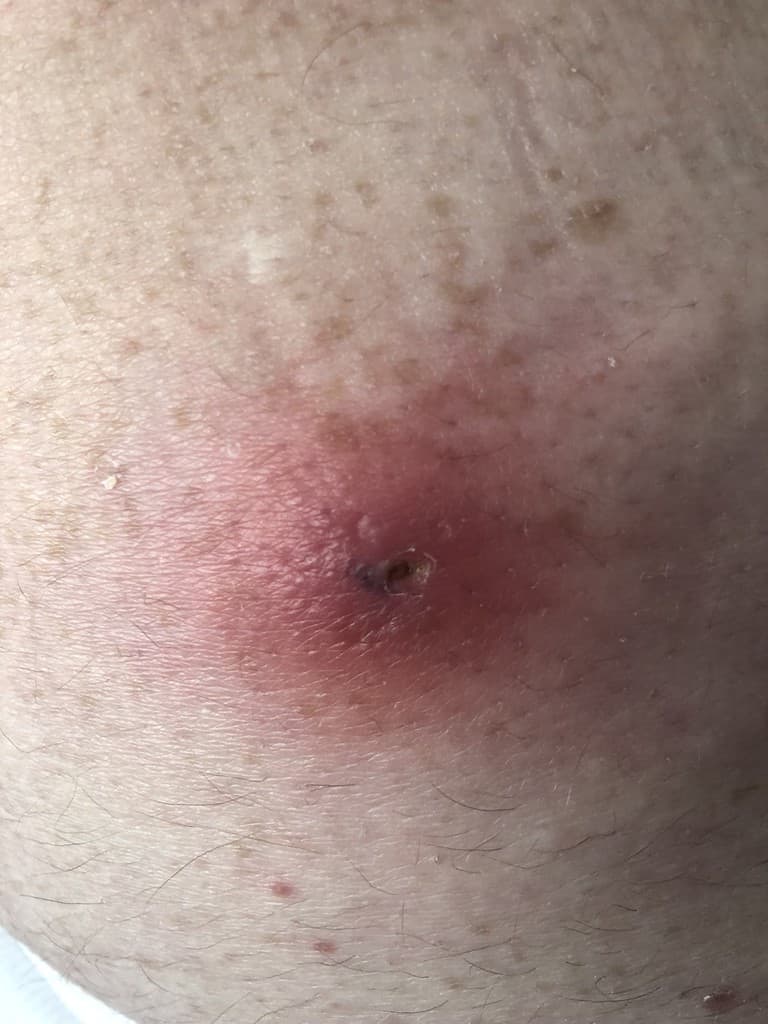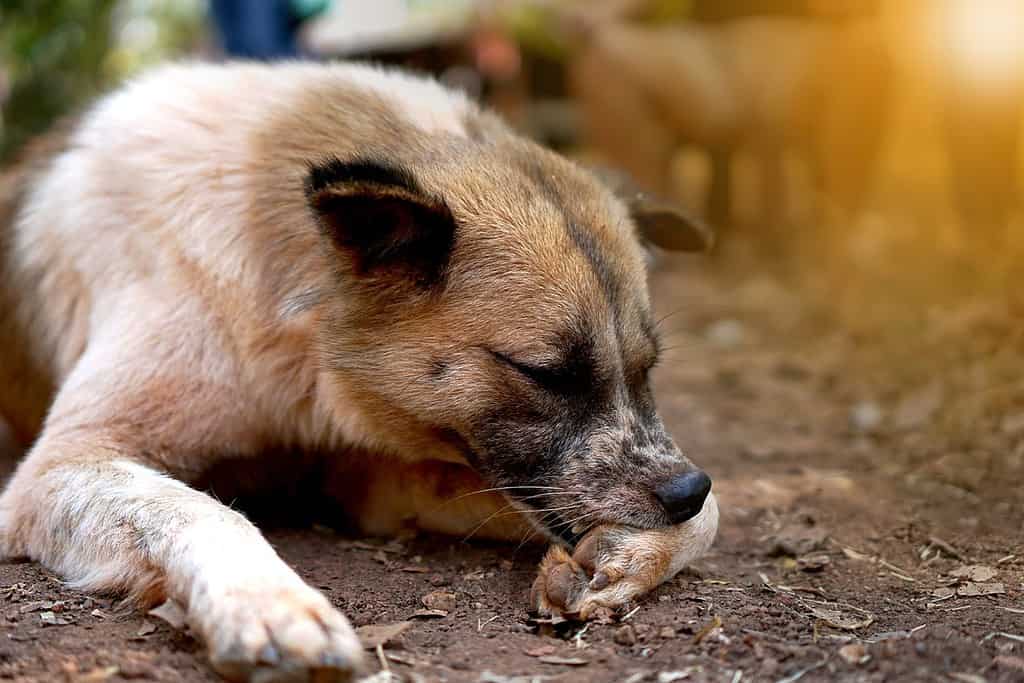Few creatures are as horror-inducing as flesh-eating maggots. Mango worms are particularly disturbing, as they burrow under the skin and grow, then burst out as large larvae. Any bird or mammal can be infected with them, including humans, but they are particularly a scourge for outdoor dogs. In this article, we tell you about their life cycle and how to protect yourself and your pets. Be forewarned that some of the images and video links below may be disturbing to some, so exercise appropriate caution.
What Are Mango Worms?

As the name suggests, mango flies predominantly feed on mangos in tropical climates.
©SHOOTKART/Shutterstock.com
Mango worms are the parasitic larvae of Cordylobia anthropophaga, a blowfly known as the mango fly. The flies’ main diet is overripe fruit. They are found mainly in Africa but have also spread to parts of South America and Asia. In the United States, they are rare but can show up in fruit, baggage, animals, or people arriving from abroad.
Life Cycle of the Mango Worm

As mango worms grow under the skin, they form a boil that will burst, and release grown worms.
©Dr. Wolfgang PFÄFFL, CC BY-SA 4.0 , via Wikimedia Commons – License
Mango Fly Eggs
A mango fly lays hundreds of eggs at a time in damp, humid places that have the smell of urine, feces, or sweat. This can include soil, bedding, towels, or clothing that are left outdoors. Even clean clothes can be infected though, such as damp laundry drying on a clothesline. The eggs are usually too small to be noticed by the human eye. They hatch within a couple of days and can live without a host for up to two weeks.
How the Larvae Find a Host

The paws are a common area for mango worm infestation in dogs.
©GikaPhoto By waraphot/Shutterstock.com
When the larvae get on a living being they will create a pinhole in the skin and burrow down to eat subcutaneous tissue and fluids. They’re most likely to infect rodents and other wild animals, outdoor dogs, and people who are in contact with them or who spend time working in the soil. Victims might also get the eggs or larvae into an open wound, through the nose or ears, or by being bitten by a mosquito or tick infected with mango worms.
Dogs often get infestations in their paws, their sides, and underbellies: places that are in contact with the soil as they lay on the ground. In humans, thin-skinned areas such as the back of the arms, the hips, the lower back, and the buttocks are some common areas of infestation. The medical name for such an infestation is cutaneous myiasis.
Larvae Growth and Shedding
The larvae grow rapidly to a centimeter long in their first week as they tunnel around under the skin. They create red boils that will burst and release them when they are ready for their next stage of life. Each, by now up to 2 centimeters long, falls on the ground, burrows into the soil, and transforms into a hard-shelled pupa. In 10-14 days, an adult mango fly emerges and repeats the vicious cycle.
How Serious Is a Mango Worm Infestation?

The pits on this puppy’s belly, legs, sides, and face are scars from a mango worm infestation.
©Agarianna76/Shutterstock.com
A mango worm infestation is not comfortable but fortunately is usually not immediately life-threatening. Any person who is infected with them or has an infected dog will surely want them immediately removed, though. The victim may feel intense itching and pain and may be horrified to see and feel the worms moving under the skin. Understandably, the distress can cause a racing heartbeat and insomnia. Left untreated, a life-threatening bacterial infection could result.
Depending on where they burrow, mango worms can also damage sensitive organs. In fledgling birds, for example, the internal organs are easily accessible through a thin layer of skin. In a dog, worms around the anus or other bodily orifices can create open wounds, debilitating the animal from blood loss. Even when the infestation clears up, the severity of the wounds can leave the host with permanent pitted scars.
Preventing and Treating Mangoworm Infestations

Yeah, buddy, baths are not fun. But worms are even less fun.
©Arman Novic/Shutterstock.com
Preventing Mango Worms
Dogs that live indoors are far less likely to acquire mango worms. If you do keep your dog outside, try to keep it from digging in areas where there might be a lot of urine, feces, and damp soil that will attract mango flies. Bathe the dog frequently, feeling and examining his body for red pimples or sores where mango worms may be developing. Use a veterinarian-recommended fly repellant on your dog. Wash its bedding frequently in the hottest water and the hottest dryer settings possible. Vacuum its living spaces regularly.
Of course, most of this applies to you and your family as well. Though sun-dried clothes might smell nice and be environmentally friendly, weigh this against the risk of parasites in your area as you decide whether or not to use a dryer. If you have a mango tree or other fruit trees on your property, make sure to keep fallen and rotting fruit cleaned up to avoid attracting flies. Dispose of fruit peels and leftovers in a garbage disposal or sealed garbage bag.
Treating an Infestation

Here, a veterinarian in Gambia applies gentle pressure to pop mango fly larvae out of a puppy’s paws.
©Agarianna76/Shutterstock.com
Treating a mango worm infestation in yourself or your dog is not a “do-it-yourself” opportunity. There is a significant risk of an infection or spreading the infestation if it is not handled properly. It can also be extremely painful for a person or animal to remove mango worms without at least a local anesthetic.
A medical or veterinary professional will sanitize the wound properly, then apply petroleum jelly or liquid paraffin to the boils. The small pinhole in the center of the boil is the breathing tube for the larva. When this is blocked off the larva will begin to suffocate and seek the exit. After 30-60 minutes, the professional will apply gentle pressure with the fingers to pop out the larvae. If this is done too roughly, it can cause the worm itself to rupture inside the body or can push it deeper into the body – yet another good reason to leave it to the professionals!
Severe abscesses or open wounds may require further medical attention and bandaging. The patient is likely to get a prescription for antibiotics after the treatment. And, in the case of a four-legged patient, there may be a “cone of shame” to prevent licking at wounds.
Not For the Faint of Heart
For those who are curious about what a real infestation looks like, check out the video below. You’ll see a veterinarian in the West African country of Gambia professionally removing mango worms. Warning though, some viewers may find it disturbing. Watch at your own risk!
The photo featured at the top of this post is © Makistock/Shutterstock.com
Ready to discover the top 10 cutest dog breeds in the entire world?
How about the fastest dogs, the largest dogs and those that are -- quite frankly -- just the kindest dogs on the planet? Each day, AZ Animals sends out lists just like this to our thousands of email subscribers. And the best part? It's FREE. Join today by entering your email below.
Thank you for reading! Have some feedback for us? Contact the AZ Animals editorial team.






